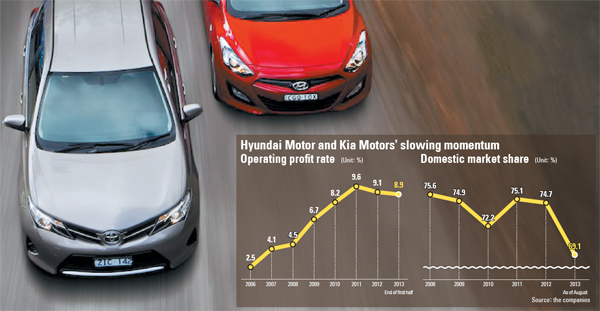Hyundai and Kia yield to Toyota

The Korean company announced Sunday that its operating profit rate in the first half of the year was 8.9 percent, compared with 10.5 percent for the first six months of 2012. BMW was No. 1 in operating profit rate during the first half of last year at 11.7 percent, compared with 11.1 percent this year.
Toyota’s operating profit rate in the first half was 9.6 percent, after recording only 5.3 percent a year ago.
It was another discouraging sign for the largest Korean automaker, after its domestic market share slumped below 70 percent in August for the first time since September 2008.
With statistics showing stagnant sales, there is growing concern that without aggressive measures to combat low productivity and delays in product launches, the Korean company may be thrown into a larger crisis in the near future.
In the wake of the global crisis, the Korean automaker aggressively moved to expand its world market share. One highly unusual promotion in the United States offered refunds if buyers lost their jobs.
Additionally, Hyundai and Kia had an advantage on price competitiveness thanks to the weak Korean currency against the U.S. dollar.
Meanwhile, Toyota struggled after the Japanese automaker was embroiled in a series of legal actions involving sudden unintended acceleration of its vehicles. The issue tarnished Toyota’s brand image and damaged consumer confidence in the safety of its products.
But the tables have turned, in part, due to the Japanese government’s aggressive monetary policy that has resulted in a devalued yen.
Toyota in the first half of this year was able to recover its top spot in global sales with $121.9 billion?in revenue and operating profit of $11.7 billion, 97 percent higher year-on-year.
Meanwhile, Hyundai and Kia face challenges from foreign competition in the domestic market, questions about product quality and labor issues. Their market share dropped to 69.1 percent, the lowest in five years.
Company insiders regard the decline as “an instantaneous phenomenon caused by partial strikes.” Domestic production of Hyundai and Kia cars shrank 5.6 percent earlier this year when union members refused to work weekend shifts for about two months.
The only country in which Hyundai and Kia are doing well is China, where sales increased 32 percent in the first half of this year. And they are likely to reach their 2013 country sales goal of 1.47 million units.
However, some say there is too much reliance on the Chinese market, which accounts for 20 percent of Hyundai and Kia’s worldwide sales.
Some contend the two companies lack the will to innovate, saying they have been slow to introduce new models and react to trends. In August, Hyundai Motor introduced a new Avante for the first time in four years in response to growing consumer interest in diesels.
“Their renewed cars introduced around 2010 like Genesis, YF Sonata, Avante MD, K5, Soul, Tucson ix and Sportage R were innovative enough in design and quality,” said an auto industry insider who asked for anonymity. “To end the stagnant period, Hyundai and Kia have to revive their thirst for bold innovation.”
BY Park Jin-seok [jiyoon.kim@joongang.co.kr]










with the Korea JoongAng Daily
To write comments, please log in to one of the accounts.
Standards Board Policy (0/250자)